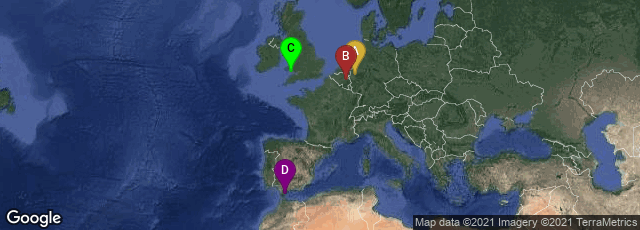
A: Neanderhöhe, Erkrath, Nordrhein-Westfalen, Germany, B: Flémalle, Wallonie, Belgium, C: Swansea, Wales, United Kingdom, D: Gibraltar, Gibraltar
In August 1856, laborers in a mining operation discovered human bones in the Kleine Feldhofer Grotte in the Neandertal (Neanderthal), a small limestone valley in northern Germany. This finding, consisting of a partial skull, pelvis and assorted long bones, which later became known as Neanderthal 1, became the first specimen to be recognized as an early human fossil. The oval shaped skull with a low, receding forehead and distinct browridges, the thick, strong bones were distinctly different from modern humans.
The bones were sent to Johann Carl Fuhlrott, a science teacher in Elberfeld, who immediately recognized that the bones were a previously unknown type of human. This conclusion was borne out by Hermann Schaaffhausen, a physician and anthropologist in Bonn to whom Fuhlrott sent a cast of the cranium. Over the winter of 1856–57 Schaaffhausen examined the Neanderthal bones in detail, and in 1857 he and Fuhlrott published preliminary announcements of the discovery in the Verhandlungen. des naturhistorischen Vereines des preussischen Rheinlande und Westphalens.XIV (1857) xxxviii-xlii, l-lii. Fuhlrott’s account appears on page l (Roman numeral pagination).
In 1864, Neanderthal 1 became the first fossil hominin species to be named. Geologist William King suggested the name Homo neanderthalensis (Neanderthal Man). Several years after Neanderthal 1 was discovered, scientists realized that prior fossil discoveries, by Philippe-Charles Schmerling in 1829 at Engis, Belgium, and in 1848 at Forbes Quarry, Gibraltar (Gibralter 1)—were also Neanderthals. Even though they weren’t recognized at the time, these earlier discoveries, and that of the so-called "Red Lady of Paviland" by William Buckland at Paviland Cave (Goat's Hole) South Wales in 1823, were among the first early human fossils ever found.
♦ As recently as March 1999 archaeologists Ralf Schmitz and Jurgen Thissen pinpointed the site where Neanderthal 1 was discovered in 1856, and dug up missing parts of the original skeleton that had been passed over in the original excavation. They found 20 bone fragments— a molar, a vertebra, ribs, a toe, and a bit of pelvis; one of the fragments exactly fit the left knee joint of the specimen found in 1856. Continuation of the excavation in 2000 recovered thousands of artefacts. Mitochondrial DNA of two samples fresh from the ground were fully sequenced, and completed in 2009, finally allowing an objective biological means of comparison between Neanderthals and modern humans.